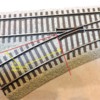In the past I posted my attempt to modify original Gilbert turnouts so that the diverging track curvature was greatly reduced. That method worked out OK.
I decided to put my "scrubs" back on, sharpen up the scalpels (bandsaw and dremel) and have a go at modifying original SHS (now MTH) turnouts to achieve a similar result.
The only reason I tried this is because a fellow S gauge friend came across 4 derelict SHS turnouts that had seen better days and we wanted to see if this modification could be done.
What I started with was a pair (L and R) of SHS turnouts that have the customary r20 diverging track like this:
If you have ever tried to make a passing siding with SHS turnouts you know that you may need a "filler" to connect back up to the opposing turnout. I wanted to avoid that issue so I paid specific attention to the length of the newly created diverging leg of the turnout. I chose to use r24 SHS curves for the donor tracks:
The general idea is to
A. cut off the diverging track on the turnout,
B. cut the donor track to a length that allows standard sections of straight track to complete the run to the other turnout and
C. secure the cut donor track to the turnout.
First cut the diverging leg of track off the switch. Using a dremel cut the outer rail where shown in the following photo. Pull off (out) both short sections of rail and then cut the roadbed where shown. (The outer rail cut needs to be a 90 degree cut as measured across the roadbed.)
Next you need to cut the donor track to a length that makes the outer rail 9" long. (Your results may vary depending on how you cut the turnout). Always err on the long side of things...you can always cut or file a bit more but you can't put it "back on". ![]() You'll also have to cut some of the roadbed along the inside of the curve to allow straight track sections to join the straight portion of the turnout.
You'll also have to cut some of the roadbed along the inside of the curve to allow straight track sections to join the straight portion of the turnout.
What you'll end up with is something like this:
Note that the outer cut rail on the donor curve is secured to the outer cut rail on the turnout with a rail joiner.
Where the roadbeds of the two tracks join is a real problem. You'll need to study long and hard at the two tracks penciling in a guide line as to where to make the cuts.
The underside of the newly joined tracks needs to be secured back together. You could use many types of glue...hot glue, epoxy, contact cement , etc. I chose to use clear caulk as an adhesive with bits of cut roadbed as "bridges" across the joined areas:
There's not a lot more to tell you about this modification. Just remember to take lots of time studying any proposed cuts before you make the cut. As to wiring the newly joined donor rails that's a topic for another time. This post is to show that it can be done. I think the roadbed cuts could be dressed up a bit better with some scenic elements such as ballast and glue but for now I have a working model of surgically altered SHS turnouts:
Note that all the straight 10" sections of track remain uncut. The center to center spacing of the straight and divergent tracks is now right at 2 5/8". That's just about what was achieved in the original Gilbert Turnout surgery and is a vast improvement over original SHS/MTH track centers:
So while I know not many people will attempt this modification (Heck I wouldn't have if it weren't for these junker turnouts!) at least now MTH will see that it could be done in a revised turnout release perhaps 200 years in the future! ![]()
Mark






